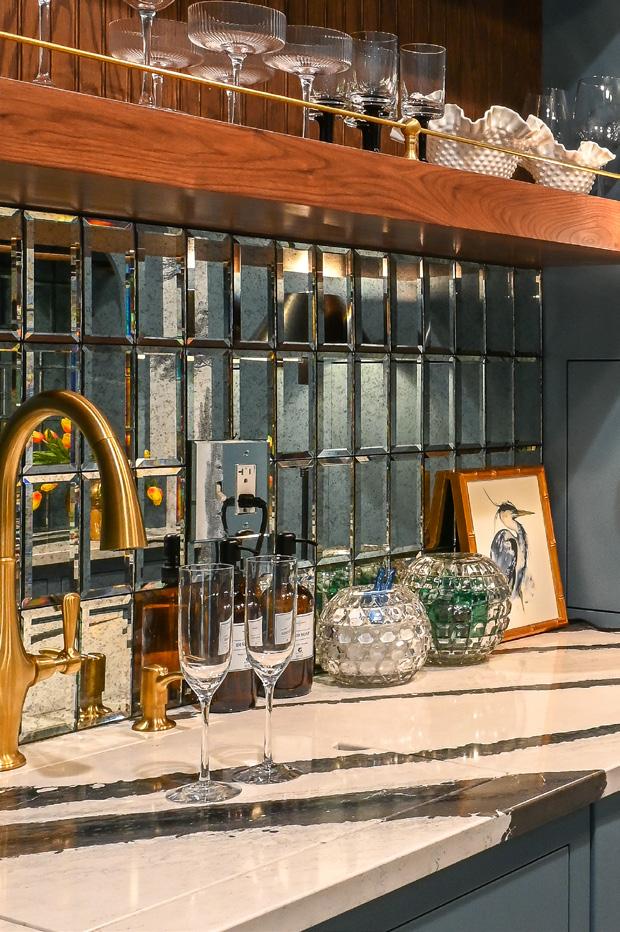
4 minute read
SENSOR-BASED




In the open living room, the fireplace is the main feature. The off-center mantle is one giant piece of wood, carved by a neighbor, according to local history enthusiasts. The oversized sectional from West Elm suited the scale of the room. For the color palette, Jones opted for rusty oranges, teal, gray, and creamy whites. In the adjacent dining room, a custom-made wood table comfortably seats eight. A diagonal pattern is inlaid in the top, while the angled base is made of steel. Jones adds, “I made an effort to keep all of the furnishings low, so that the sight lines to the exterior aren’t obstructed.”
For Jones, the same principle applies in the kitchen; “You want to look up and out at the nature beyond, and not focus on the details.” The original rosewood veneer cabinets are lovingly and carefully removed and cleaned with mineral spirits and wax annually. The original Frigidare oven still works, putting out the most consistent heat without all the unnecessary bells and whistles. For the backsplash, Jones opted to introduce a stainless steel hexagon tile as opposed to something colorful that could detract from the architectural beauty.
The home is resplendent. Carefully curated objects grace each room—an old sewing machine table now serves as the front console, and an original rendering of the home has been framed and hangs near the front door. It manages to feel honest and relevant, connected to nature in a simple and straightforward manner. “Each season is special,” Jones says. “In the spring, the rain spills across the overhang like a waterfall. In the winter, the snow falling feels like a snow globe.”
Jones’ design advice for creating a home as warm and welcoming? “Old houses will teach you patience. And you have to be patient with decorating—resist buying all new. Be sure to include pieces that have a bit of history and soul.”

SENSOR-BASED LIGHTING
Take a load off your brain—and the planet—with smart lighting.
Smart home technology is growing in popularity, and for good reason. Rather than rely on our overloaded human brains to remember when and where we need things on or off (and actually remembering to flip the switch when we leave a room), we can harness robot power to take care of it for us. When it comes to lighting, motion sensors and remote controlled lighting not only make our lives easier but take a load off the planet, too.
MOTION SENSORS
Becoming more common in U.S. homes each year, motion sensors ensure that lights are on when you need them to be, and off when you don’t. The second you walk into the room they’ll switch on, and shut off when it no longer perceives movement.
That’s pretty convenient, especially when your hands are full walking in the door after a long shift at work, wrangling children to and fro, or taking care of housework. And if your hands are that busy, your brain probably is, too. No matter your intentions, the best of us have forgotten to turn a light off before leaving for the day or even on a vacation. Relying on sensors to turn lights off for you means saving money on your energy bill and reducing the impact on Mother Earth.
SMART SYSTEMS
Smart systems offer another way to take human error off the table. Bluetooth appliances, plugs, bulbs, and fully integrated smart home systems let you control lights from afar through your phone or your voice. Set your lights to follow a regular schedule, dim the lamp in your kids’ rooms before bed, or make sure everything is off even after you leave the house with ease.
Smart and sensor-based lights make sense in most places throughout the house, but some of the most popular places include bathrooms, kids’ rooms, closets, garages, and porches. These are places where you’re more likely to forget to turn lights on and off, use lights for short periods of time, or want to have control over them from a distance. The next time you stumble up a pitch-black driveway or fumble down the stairs in the middle of the night for a midnight snack, think about how much easier it would be if your lights just knew you needed them in that moment.
It’s pretty easy to get started with sensor and smart lighting technology. The simplest method is to replace your regular bulbs with bulbs that detect motion or smart bulbs that connect to wifi. Phillips, Wyze, and Sengled all offer affordable and reliable bulbs to swap out with your current set. If you don’t want to fully replace your bulbs, check out smart plugs from brands like Phillips, Amazon, and Wemo. These offer the added bonus of putting a smart spin on anything you plug in, not just lights, so you can upgrade all of the technology in your home. If you are building, talk to your builder and designer about smart home integration. N









